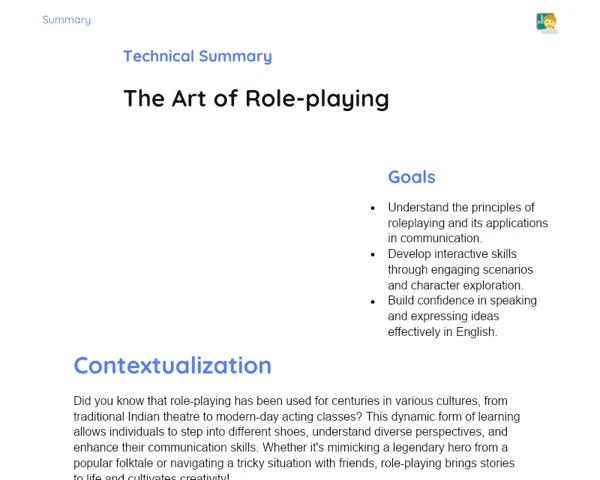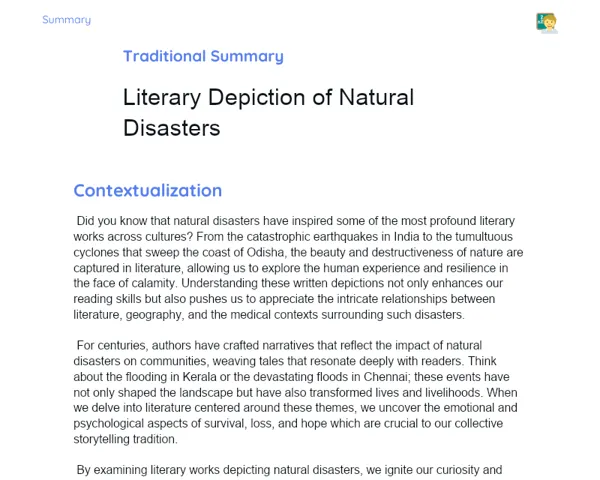Diving Into the Heart and Mind of Stories! 💖📚
Goals
1. Understand the main character's thoughts and feelings in the story
2. Relate the character's emotions to personal experiences
3. Enhance empathy by considering how others might think and feel
Contextualization
Did you know that stories have a magical way of connecting us with our own emotions? 🌟 When we dive into the thoughts of a character, it's like peeking inside their heart! For example, in our beloved tales, whether it’s about a brave hero from the Mahabharata or a clever child in a modern-day setting, understanding their feelings makes the story come alive, allowing us to feel their joys and sorrows as if they were our own!
Exercising Your Knowledge
Character Emotions
Every character in a story has emotions that drive their actions and decisions. When we explore these feelings, we gain insight into why they behave in certain ways. For instance, in our local folktales, characters may feel happiness when they achieve something or sadness when they face obstacles. Understanding these emotions helps us connect with the character on a deeper level, allowing us to empathize with their joy, anger, or sorrow, which reflects our own experiences in life. This connection not only enhances our enjoyment of the story but also teaches us to recognize and manage our own emotions.
-
Empathy Development: Recognizing a character's emotions helps us develop empathy. When we relate to their feelings, we learn to understand others better in real life.
-
Personal Reflection: Understanding a character’s emotions encourages us to reflect on our own feelings. It helps us ask questions like, 'How would I feel in that situation?'
-
Enhanced Story Engagement: When we connect with a character's emotions, we become more invested in the story, leading to a richer reading experience.
Thought Processes
The internal thoughts of characters reveal their motivations and conflicts. For example, a character might feel conflicted about making a decision—should they be the hero and take a risk, or play it safe? Exploring these thought processes allows us to peek into their minds, increasing our understanding of their struggles and triumphs. This reflection can mirror our own thought patterns, helping us think critically about our decisions and develop problem-solving skills in our lives.
-
Critical Thinking: Analyzing a character's thought process encourages critical thinking. Students learn to assess different viewpoints and outcomes, just like we do in real-life situations.
-
Self-Awareness: By understanding a character’s internal debates, we can identify our own thoughts and feelings, leading to greater self-awareness and emotional regulation.
-
Conflict Resolution: Learning about characters facing dilemmas helps us navigate our own conflicts. We can draw lessons from their choices and apply them to our lives.
Cultural Context of Emotions
Emotions often reflect the cultural context of a story. For instance, in Indian narratives, familial ties and community bonds are emphasized. Characters may express love, bravery, or sadness uniquely influenced by cultural norms and values. Recognizing this cultural context enriches our interpretation of the story and fosters appreciation for diverse emotional expressions. It teaches us that emotions are universal, yet they can be expressed and experienced differently across cultures, which is vital in our multicultural society.
-
Cultural Appreciation: Understanding the cultural context of emotions enhances our appreciation of different storytelling traditions and perspectives.
-
Global Mindset: Recognizing emotional expressions in various cultures prepares us to engage with a global community, fostering understanding and respect among diverse backgrounds.
-
Celebrating Diversity: By exploring characters from different cultures, we celebrate diversity and learn to embrace the uniqueness of emotions and experiences around us.
Key Terms
-
Empathy: The ability to understand and share the feelings of another.
-
Character Motivation: The reasons behind a character’s actions and decisions in a story.
-
Cultural Context: The background, values, and norms that influence how emotions are expressed in stories.
For Reflection
-
Think about a time when you felt similar emotions as a character from a story. How did understanding those emotions affect your experience of the story?
-
Reflect on how different characters handle similar situations. What can you learn from their reactions and decisions in your own life?
-
Consider how cultural differences influence emotional expression in the stories you’ve read. How can understanding these differences help you relate to others better?
Important Conclusions
-
Understanding the main character's thoughts and feelings allows us to connect deeply with stories, enhancing our empathy and emotional awareness.
-
Recognizing the cultural context of emotions enriches our interpretation, helping us appreciate diverse perspectives and responses in storytelling.
-
Relating character emotions to our own experiences fosters reflection, encouraging us to think critically about our actions and reactions.
Impacts on Society
In today's fast-paced world, understanding emotions—both our own and others'—is crucial. When we read stories and grasp the thoughts of characters, we apply that knowledge to our everyday interactions. This develops our emotional intelligence, enabling us to respond compassionately to our friends, family, and even strangers. Moreover, it encourages us to communicate effectively and fosters harmony in our multicultural society. By promoting empathy through storytelling, we not only enhance our relationships but also contribute to a more understanding and cohesive community.
Additionally, stories help us navigate challenges we face in school and at home. When we recognize the emotions of characters facing adversities, we can learn to manage our frustrations or joys in real life. This reflective ability allows us to support peers who may be experiencing similar feelings, cultivating a supportive environment. The skills we develop through understanding stories play a vital role in shaping us into compassionate individuals who can positively impact our society.
Dealing with Emotions
For our home exercise, let's dive deeper into the emotions we experience while reading! First, pick a short story or a chapter from a book you enjoy. Read it carefully and whenever a character expresses an emotion, pause and recognize that feeling in yourself. Ask yourself: 'When was the last time I felt this way? What triggered my feelings?' Next, label the emotions you identified—was it happiness, sadness, or perhaps confusion? Afterward, write down a few sentences expressing how you would react if you were in the character's shoes. Finally, think about how you can regulate those emotions in real life. Is there a friend you can talk to? Or a creative way to express those feelings? Remember, understanding emotions is a journey, and every step helps us grow!
Study Tips
-
Discuss your favorite characters with friends or family—share their emotions and thoughts, and see how they relate to your own feelings!
-
Keep a journal where you write down characters' emotions you notice and relate them to your own life experiences—this will deepen your understanding!
-
Watch a movie or read a story from a different culture and note how emotions are expressed—compare these with your own emotions and interpretations!



